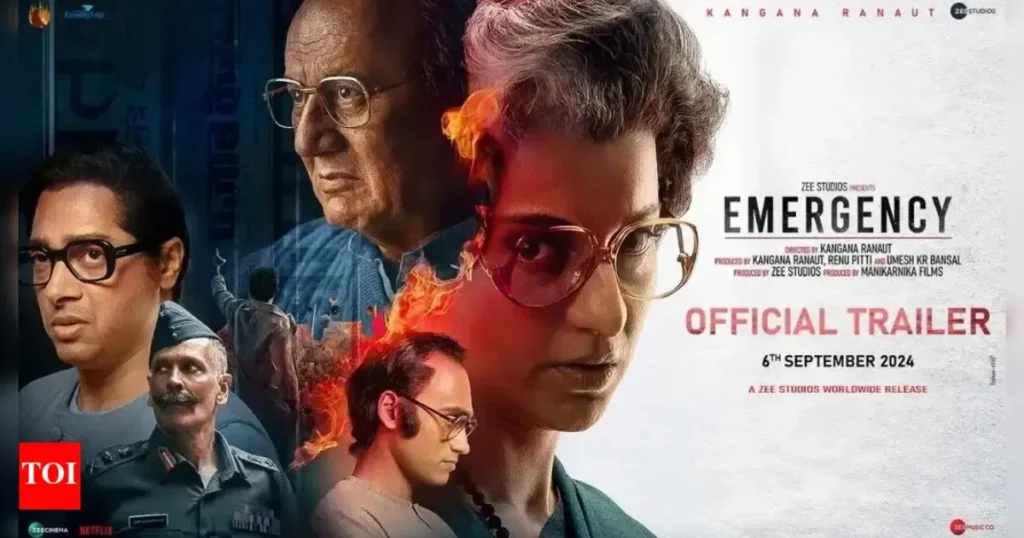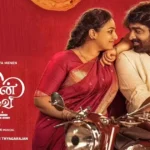The 2025 Indian Hindi-language historical biographical drama emergency movie review, directed and co-produced by Kangana Ranaut, dives into one of the most controversial periods in Indian history—the Emergency of 1975–1977. With Ranaut also starring as former Prime Minister Indira Gandhi, the film aims to capture the political upheaval, personal struggles, and societal impact of this tumultuous era. Released on January 17, 2025, after delays due to certification issues with the Central Board of Film Certification (CBFC), Emergency has sparked heated discussions among audiences and critics alike. This comprehensive, spoiler-free review explores the film’s plot, cast performances, direction, screenplay, cinematography, music, visual effects (VFX), strengths, weaknesses, audience and critics’ reactions, box office performance, comparisons to similar films, and a final verdict with a star rating.
emergency movie review details
|
Aspect |
Details |
|---|---|
|
Title |
Emergency |
|
Release Date |
January 17, 2025 |
|
Director |
Kangana Ranaut |
|
Producer |
Kangana Ranaut, Renu Pitti |
|
Screenplay |
Ritesh Shah |
|
Story |
Kangana Ranaut |
|
Cast |
Kangana Ranaut, Anupam Kher, Shreyas Talpade, Mahima Chaudhry, Vishak Nair |
|
Genre |
Historical Biographical Drama |
|
Runtime |
146 minutes |
|
Language |
Hindi (with English subtitles) |
|
Certification |
CBFC (India), suitable for mature audiences due to graphic violence |
|
Production Companies |
Manikarnika Films Pvt Ltd |
|
Distributor |
Netflix (post-theatrical release) |
|
Budget |
Estimated ₹50–60 crore |
|
Box Office |
Flopped, with weak opening collections despite Cinema Lovers Day offer |
Spoiler-Free Plot Summary
Emergency chronicles the life and political career of Indira Gandhi, India’s first and only female Prime Minister, with a focus on the infamous Emergency period (1975–1977). The narrative spans several decades, beginning with a young Indira in 1929, shaped by her father, Jawaharlal Nehru, India’s first Prime Minister. The film traces her rise within the Congress Party, initially underestimated as a “gungi gudiya” (dumb doll) by party elders, and her transformation into a formidable leader. It highlights key historical events, including India’s Independence, the 1962 Indo-China War, the 1971 Indo-Pak War, and the controversial Emergency, during which civil liberties were suspended, the press was censored, and forced sterilizations were implemented under the Maintenance of Internal Security Act (MISA).
The story delves into Indira’s political dilemmas, her consolidation of power, and her complex relationship with her son, Sanjay Gandhi, whose influence during the Emergency led to controversial policies. The film also portrays the resistance from opposition leaders and the struggles of ordinary citizens caught in the political turmoil. Without revealing specific plot points, Emergency attempts to balance Indira’s ambition, pragmatism, and vulnerabilities while navigating the moral and political complexities of her decisions.
Cast Performances
Kangana Ranaut as Indira Gandhi
Kangana Ranaut’s portrayal of Indira Gandhi is the heart of Emergency. Her physical transformation, aided by David Malinowski’s prosthetics, is striking—capturing Gandhi’s iconic hairstyle and attire with precision. Ranaut’s performance is a mixed bag, however. At times, she embodies Gandhi’s commanding presence and quiet ruthlessness, delivering powerful scenes that showcase her as a defiant, patriotic leader. Her ability to mimic Gandhi’s mannerisms, particularly in moments of political intensity, is commendable. However, critics have noted that her portrayal occasionally veers into caricature, with overly dramatic expressions and a high-pitched, shaky voice that undermines the character’s authority. Some reviewers argue that Ranaut’s Indira oscillates inconsistently between a strong leader and a vulnerable, teary-eyed figure, making it hard for audiences to connect fully.
Supporting Cast
The ensemble cast, including Anupam Kher, Shreyas Talpade, Mahima Chaudhry, and Vishak Nair, delivers solid performances but is often underutilized. Anupam Kher, as a key political figure (likely Jayaprakash Narayan), brings gravitas and emotional depth, though his screen time is limited. Shreyas Talpade, portraying Atal Bihari Vajpayee, is praised for his accurate depiction of the opposition leader’s demeanor, but his role feels like a cameo. Vishak Nair’s portrayal of Sanjay Gandhi stands out, capturing the character’s arrogance and influence with nuance, making him a compelling foil to Ranaut’s Indira. Mahima Chaudhry, as Pupul Jayakar, struggles with a poorly defined role due to the screenplay’s lack of context for her character. Other supporting actors, including those playing historical figures like Sam Manekshaw and Jagjivan Ram, are competent but reduced to caricatures in some scenes, limiting their impact.
Direction
Kangana Ranaut, making her directorial debut, takes on an ambitious project with Emergency. Her vision to portray a pivotal chapter in Indian history is bold, and she handles the film’s scale with a degree of competence. Ranaut ensures the grandeur of political settings doesn’t overshadow the human elements, particularly in scenes depicting Indira’s personal struggles. However, her inexperience as a director shows in the uneven pacing and tonal inconsistencies. The film struggles to balance historical accuracy with cinematic drama, often leaning into theatrical moments that feel out of place, such as a bizarre musical sequence in Parliament. Critics have noted that Ranaut’s direction lacks the finesse needed to weave a cohesive narrative, resulting in a film that feels like a series of historical vignettes rather than a unified story.
Screenplay
The screenplay, penned by Ritesh Shah with a story by Ranaut, draws from real-life events and books like Priyadarshini by Jaiyanth Vasanth Sinha and The Emergency: A Personal History by Coomi Kapoor. It is gripping in parts, with a constant stream of events that keep viewers engaged. However, the narrative suffers from a lack of fluidity, often adopting a documentary-like tone that feels disjointed. Key events, such as the Allahabad court case and Sanjay Gandhi’s rise, are introduced abruptly, leaving audiences confused. The dialogue, while sharp and realistic at times, occasionally resorts to clichés and expository voiceovers that undermine the film’s subtlety. The screenplay’s attempt to humanize Indira Gandhi is admirable, but its oscillation between glorifying and vilifying her creates a confusing portrayal.
Cinematography
Cinematographer Tetsuo Nagata delivers a visually striking film that captures the oppressive atmosphere of the Emergency era. Using muted color palettes and shadowy frames, Nagata evokes the tension and uncertainty of the time. Key scenes, such as the Pokhran nuclear test and parliamentary sessions, are visually compelling, with detailed production design by Wasiq Khan and Rakesh Yadav enhancing the period authenticity. However, some scenes are marred by choppy editing and abrupt transitions, which disrupt the visual flow. The cinematography shines in moments of political intensity but struggles to maintain consistency in quieter, character-driven scenes.
Music
The soundtrack, composed by G.V. Prakash Kumar and Arko, includes four songs that fail to leave a lasting impression. While the music aims to integrate with the narrative, it often feels out of place, particularly in scenes like the parliamentary musical number, which critics have called unintentionally comical. The background score is more effective, adding tension to key moments, but it lacks the memorability needed to elevate the film’s emotional impact. The music, while technically sound, does not contribute significantly to the storytelling.
Visual Effects (VFX)
The VFX, handled by White Apple Studio, Redefine, and Futureworks Media Ltd, are satisfactory but inconsistent. The film recreates historical settings like 1970s India with decent attention to detail, but some computer-generated imagery (CGI), particularly in war sequences, appears tacky and unpolished. Critics have pointed out that the graphic violence, including scenes of wartime atrocities, feels sensationalized and lacks context, detracting from the film’s authenticity. The prosthetics used for Ranaut’s transformation are a highlight, seamlessly blending with her performance to create a convincing Indira Gandhi.
Strengths
-
Ambitious Vision: Emergency tackles a complex and controversial period in Indian history, shedding light on lesser-known aspects of Indira Gandhi’s life and the Emergency’s impact on citizens.
-
Kangana Ranaut’s Performance: Despite inconsistencies, Ranaut’s commitment to portraying Indira Gandhi is evident, with moments of brilliance that capture the leader’s charisma and complexity.
-
Production Design: The detailed costumes, sets, and cinematography effectively recreate the 1970s, immersing viewers in the era.
-
Supporting Cast: Performances by Vishak Nair, Anupam Kher, and Shreyas Talpade add depth, even if their roles are underdeveloped.
-
Historical Relevance: The film sparks discussion about a pivotal moment in Indian democracy, encouraging viewers to reflect on power, governance, and civil liberties.
Weaknesses
-
Uneven Narrative: The screenplay’s lack of fluidity and context makes it hard for audiences to follow key events and characters.
-
Tonal Inconsistencies: The film swings between serious drama, caricature, and unintentional comedy, undermining its impact.
-
Over-Dramatization: Ranaut’s performance and certain scenes, like the musical sequences, feel exaggerated, detracting from the film’s authenticity.
-
Historical Inaccuracies: The film has faced backlash for distorting events, particularly from Sikh organizations regarding the 1984 anti-Sikh riots, and a lawsuit from Coomi Kapoor for misrepresenting her book.
-
Weak Pacing: The rushed treatment of key events and bloated exposition in others disrupts the narrative flow.
-
Limited Mainstream Appeal: The film’s heavy historical focus and graphic content may alienate audiences seeking entertainment.
Audience and Critics’ Reactions
Critics’ Reviews
emergency movie review has received mixed-to-negative reviews, with a 30% approval rating on Rotten Tomatoes based on 10 critics, averaging 4.7/10. Dhaval Roy of Times of India gave it 2.5/5, criticizing its “overly dramatised approach and one-dimensional portrayals.” Saibal Chatterjee of NDTV called it a “monumental muddle,” rating it 1.5/5 for its superficial treatment of history. Shubhra Gupta of The Indian Express echoed this, giving 1.5/5 and describing it as a “scattershot caricature” with tacky CGI. However, some critics were more positive. Deven Sharma of Filmfare and Mayank Shekhar of Mid-Day gave it 3/5, praising Ranaut’s direction and performance, while Lachmi Deb Roy of Firstpost called it a “bold cinematic retelling.” Critics are divided on whether the film is a nuanced historical drama or a biased, poorly executed biopic.
Audience Reactions
Audience responses on platforms like Reddit and Quora are polarized. Some viewers praise Ranaut’s portrayal and the film’s ambition, with comments like, “Kangana matches the aura of Indira” and “a well-made, absorbing political drama.” Others criticize its pacing, historical inaccuracies, and lack of emotional depth, with one Reddit user noting, “Kangana overdid the ticks… her Indira was weak, no authority.” The film’s controversial portrayal of the Sikh community and the 1984 riots has sparked significant backlash, with the Shiromani Gurdwara Parbandhak Committee (SGPC) calling for a ban in Punjab. Social media buzz reflects curiosity about the historical period but disappointment with the execution.
Box Office Buzz
Emergency emerged as a box-office flop, with a weak opening despite the Cinema Lovers Day offer. Reports indicate dull collections across India, attributed to its niche historical focus and controversial reception. The film’s heavy subject matter and graphic content limited its appeal to mainstream audiences, who prefer more entertainment-driven Bollywood fare. While the controversy generated some curiosity, it wasn’t enough to drive significant ticket sales. The film’s availability on Netflix post-theatrical release may boost viewership, but its commercial failure is evident.
Comparisons
Emergency invites comparisons to other Indian political biopics like The Accidental Prime Minister (2019), which faced similar criticism for selective storytelling and bias. Unlike Thackeray (2019), which focused on a regional leader with a more cohesive narrative, Emergency struggles with its broad scope. Internationally, it shares similarities with The Iron Lady (2011), a biopic of Margaret Thatcher, but lacks the latter’s emotional depth and narrative clarity. The film’s attempt to blend historical drama with human emotion recalls Lincoln (2012), but emergency movie review uneven execution prevents it from achieving the same impact.
Final Verdict
emergency movie review is an ambitious but flawed attempt to portray one of India’s most controversial political eras. Kangana Ranaut’s dedication as both director and actor is evident, and her performance has moments of brilliance, supported by a capable cast and strong production design. However, the film’s disjointed screenplay, tonal inconsistencies, and historical inaccuracies undermine its potential. While it sparks important discussions about power and democracy, it fails to deliver a cohesive or emotionally resonant narrative. For viewers interested in Indian history or political dramas, Emergency is worth a watch for its ambition and visual craft, but it falls short of being a definitive biopic.






